The Motorola Moto Z & Moto Z Force (Droid Editions) Review
by Matt Humrick on July 28, 2016 8:00 AM ESTBattery Life
Our battery life tests simulate a few common workloads while controlling as many variables as possible, including calibrating each display to 200 nits at 100% APL.
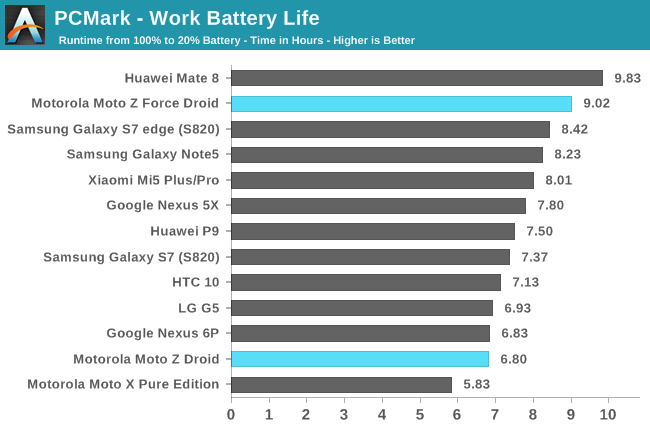
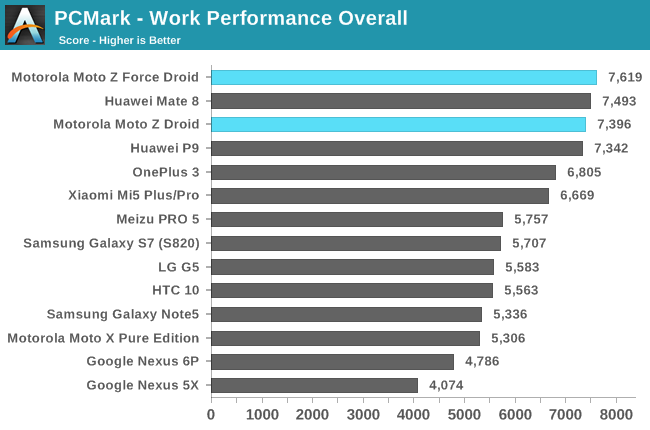
One of the primary differences between the Moto Z Droid and Moto Z Force Droid is battery size. At 2600mAh, the thinner Droid’s battery is undersized for a phone with a 5.5-inch display. The Moto Z Force Droid’s 3500mAh battery helps it last 33% (or just over 2 hours) longer in PCMark’s battery test, while the Galaxy S7 edge lasts 24% (or 1 hour and 37 minutes) longer. Even phones with smaller screens, such as the Huawei P9, HTC 10, and Galaxy S7, have larger batteries (3000mAh) than the Moto Z Droid, giving them marginally better battery life in this test. The LG G5’s battery is not much larger than the Moto Z Droid’s, so it’s no surprise they finish so close together. The Moto Z Force Droid manages to last 9 hours, longer than the other flagship phones we’ve tested except the Mate 8 and its 4000mAh battery.
After normalizing for battery size, both Moto Zs consistently last 7-10% longer in this test than other Snapdragon 820 phones. Without more specific testing it’s impossible to say if this small difference is the result of their higher-performing GPU driver allowing the Droids’ Adreno 530 to finish its work and get back to sleep more quickly, software settings, SoC binning, or something else.
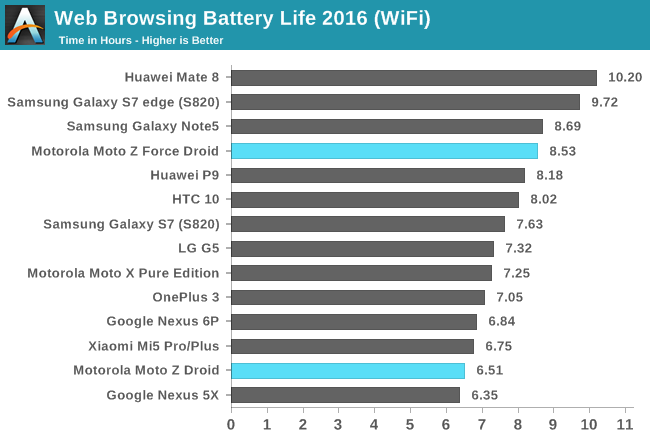
Our new browsing test makes better use of the CPU by pausing and then scrolling through each page after it’s loaded, but display power draw is still the limiting factor, with some additional power used by the wireless radio. In this scenario, the Moto Z Droids no longer show any significant advantage over their peers after normalizing for battery size. The Galaxy S7 edge’s average platform power is 11% less than the Moto Z Force Droid and the HTC 10 is 7% less than the Moto Z Droid, but the differences between the other Snapdragon 820 devices is no more than 5%. In general, battery life in this test closely follows the ratio of screen size to battery size, which puts the Moto Z Droid’s combination of a large screen and small battery at a disadvantage.
Attaching the 2220mAh Power Pack to the back of the Moto Z Force Droid extends battery life by 4.43 hours, or 52%, for a total runtime of 12.96 hours. The Power Pack adds about the same time to the thinner Moto Z, or 65%, for a total runtime of 10.72 hours. These tests were run using the “Efficiency Mode” setting that’s supposed to increase battery life by up to 20% by only charging the phone once it drops below 80% instead of keeping it topped off.

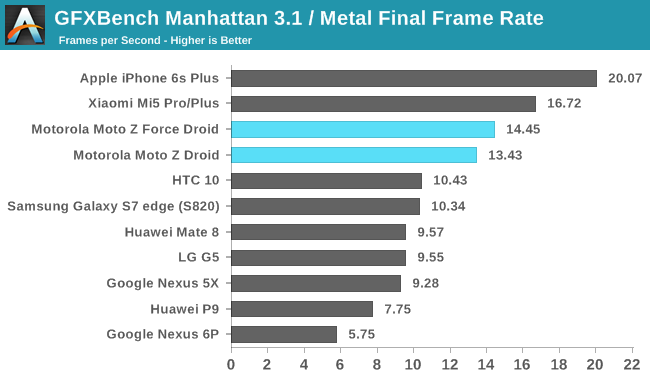
The larger battery in the Moto Z Force Droid is only good for an extra half hour of gaming in the GFXBench Manhattan 3.1 battery life test. Both Droids last more than 3 hours when pushing their GPUs hard, but they fall behind the Galaxy S7 edge and even the Nexus 6P and LG G5 in runtime; however, the Droids maintain a higher level of performance throughout the test, effectively doing more work than the other devices, which leads to the reduction in battery life. Because this test renders at the device’s native resolution, the 1080p displays in the iPhone 6s Plus and Xiaomi Mi5 Pro help them last longer and perform better than the Droids and other phones with QHD displays.
Flagship phones have enough peak performance to handle any game currently available, but they generate a lot of heat and are susceptible to thermal throttling—the process of reducing GPU frequency and performance to stay within an acceptable thermal envelope. While running GFXBench Manhattan ES 3.1, the HTC 10’s frame rate drops 35% because of throttling, eliminating its performance advantage over midrange GPUs that have better thermal stability. The Galaxy S7 edge (Snapdragon 820) also experiences a significant 33% drop in performance starting at the 8 minute mark. After dropping to a minimum of less than 8fps, performance stabilizes into a steady-state pattern after 31 minutes.
The Moto Z Droid has less thermal mass because it’s so thin, which means it should heat up more quickly than thicker phones. The graph above shows this is indeed the case, as the Moto Z Droid starts reducing GPU frequency after only 7 minutes. It reaches thermal equilibrium after 18 minutes and enters a period where it must constantly adjust frequency to stay within comfortable operating limits. Its overall performance drop of 28% is a little bit less than other Snapdragon 820 phones we’ve tested, however.
The thicker and heavier Moto Z Force Droid maintains peak performance for 12 minutes before gradually reducing GPU frequency. It takes 37 minutes to reach thermal equilibrium, with frame rates only 21% lower than peak values.
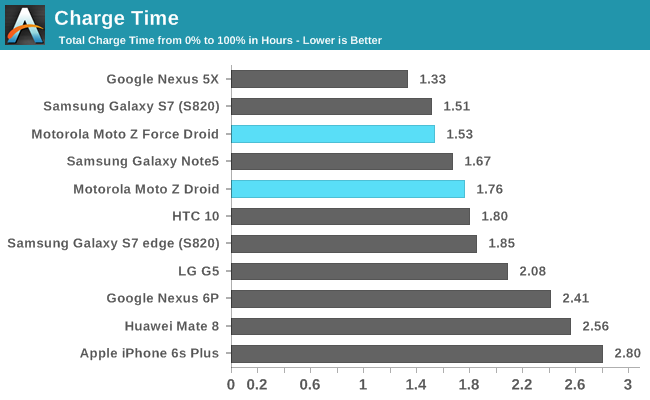
Both of the Moto Z Droids support Motorola’s TurboPower rapid charging technology. The small power bricks the phones ship with take up two slots on a standard power strip and have permanently attached cords rather than a separate cord that attaches via USB.
The Moto Z Force Droid’s charger is rated for 28.5W, which translates to a peak of 33W at the wall and 24.9W at the battery. Its peak charge cycle lasts 11 minutes and charges the battery 30% before gradually stepping down input power. The battery reaches 50% charge in 19 minutes and is fully charged in just 1.53 hours, a little faster than the Galaxy S7 edge and Galaxy Note5.
The Moto Z Droid uses a smaller 15W charger that delivers a peak of 11.1W at the battery. Its peak charge cycle lasts 43 minutes before it reduces input power. Its charge rate is slower than the Galaxy S7, especially when factoring in its larger 3000mAh battery, but its charge level still reaches 50% in 30 minutes and is fully charged in 1.76 hours.
Unlike some phones that reduce their charging rate when the display is turned on, both Moto Z Droids charge at peak levels whether the screen is on or off so long as the battery remains below its thermal threshold.



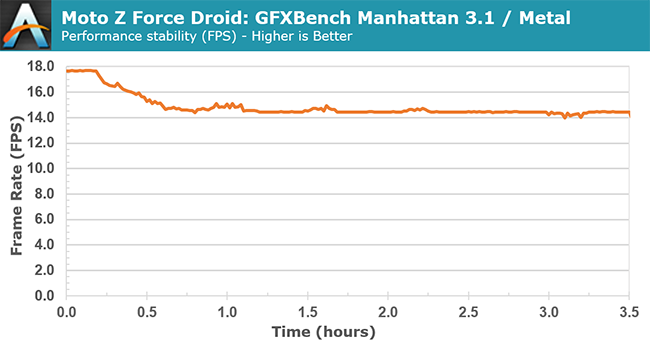
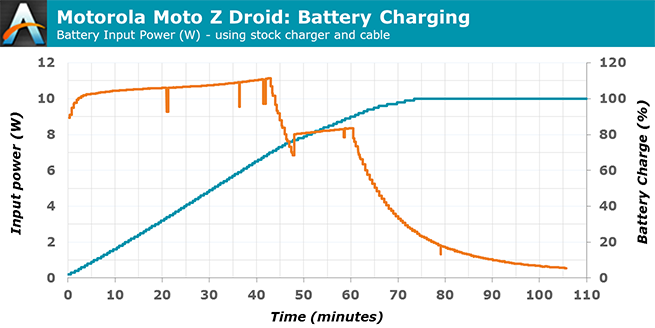
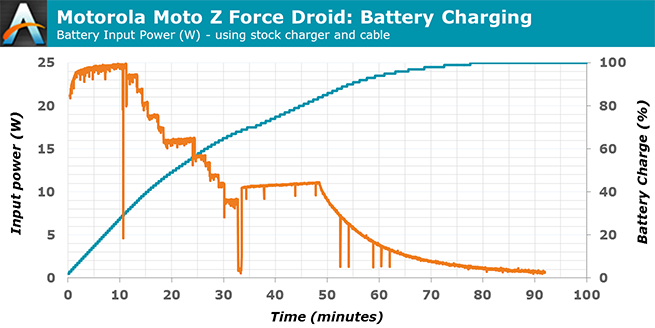








75 Comments
View All Comments
grayson_carr - Thursday, July 28, 2016 - link
I should also say, I would have bought the regular Z and put up with a battery mod if it had the same camera as the Force. Giving the $620 standard Z, the true flagship for everyone who isn't a Verizon customer, a vastly inferior camera was a big, big mistake. I think that decision will have a direct and noticeable negative impact on sales. No one wants a $620 flagship phone with a mediocre camera in 2016, and Motorola has a great camera in the Force at their disposal! It boggles the mind. Using a different camera module in one takes more engineering resources too. Stupid, stupid, stupid.mortimerr - Thursday, July 28, 2016 - link
I would love to know what the total cost for materials is for the Moto Z. The Sony IMX214 is only used in budget devices from Chinese OEMs and devices from 2014.Cliff34 - Thursday, July 28, 2016 - link
It looks more like a marketing decision than an engineering one.kmmatney - Thursday, July 28, 2016 - link
Can you put a tempered glass cover over one of these? That should keep it from scratching.peterfares - Thursday, July 28, 2016 - link
Waiting for someone to make a keyboard mod. I'll upgrade from my PRIV immediately, the SD808 is such a terrible SoC.Manch - Friday, July 29, 2016 - link
YES!!!!! Make a keyboard attachment and Ill throw my money at them. I fucking hate touch screen kb. Took me forever to give up my original Samsung Galaxy LOL.UtilityMax - Thursday, July 28, 2016 - link
Another carrier locked flagship phone priced at +600USD, or priced at 700+ USD for the non-castrated version. Big YAWN. I don't know why I'd buy this when Nexus 5X is now on an everyday sale at about 240-250USD, and Nexus 6P, together with Oneplus 3, is 400USD.fliptwister - Thursday, July 28, 2016 - link
Very good review. I agree with most of it. I picked up the Moto Z Force today at Best Buy and I'm very impressed with the phone. The Force is thinner than I was expecting and the battery time is awesome. I have been on phone now for 4+ hours non stop and have only gone through 20% of the battery. What is really impressing me is how snappy the phone feels. My wife has the LG G5 and my buddy has the S7. I have played with these phones extensively and the Moto Z is faster. Apps open instantly. There is no hesitation in any of the phone's functions. I have not tried camera yet but I'm looking very forward to it. I get what they say in conclusion about price but the deal that Best Buy has now makes this a much better deal. I bought the Moto Z Force for $524 and I got a free JBL Soundboost Speaker (valued at $80).aryonoco - Friday, July 29, 2016 - link
Thank you for your attention to monthly security updates and dedicating a good paragraph or two to the issue.No matter how good your camera is or how well-calibrated your display is, I find it completely unacceptable for an OEM to sell a product with known and published remote root vulnerabilities.
I remember a time, pre Windows XP-SP2 when Microsoft didn't provide monthly security patches, saying similar things about the need for Enterprise testing etc. Then the tsunami of malware happened and MS and the whole PC industry recognised the need for timely security updates. Google and the mobile ecosystem is now at a similar juncture. It took Google years to finally accept the need for timely security updates, but now that they do provide monthly patches, it's up to the OEMs to follow suite.
Android OEMs need to commit to monthly security updates, and need to commit to providing such updates for a set period of time after the phone is released. Selling a phone which holds so much private information with known remote kernel-level vulnerabilities is not ok. Until such time that Android OEMs understand this, my only advice to people who care about security is: buy an iPhone, or buy a Nexus.
BrokenCrayons - Friday, July 29, 2016 - link
Yeah, how about no? Aside from the name "Moto" being utterly grating to the mind to read and even stupider sounding to utter, $600+ for a phone is really exploiting peoples' lack of self control in making decisions about what to purchase..even moreso because they're going to end up paying around $2,400 more to feed it a data connection from a cellular carrier over the course of a couple years. Fine, for a lot of us that's a drop in the bucket compared to our incomes, but I see an awful lot of lower income wage workers forking over a not-insignificant chunk of their annual income to obtain a phone from their TELCO gods.